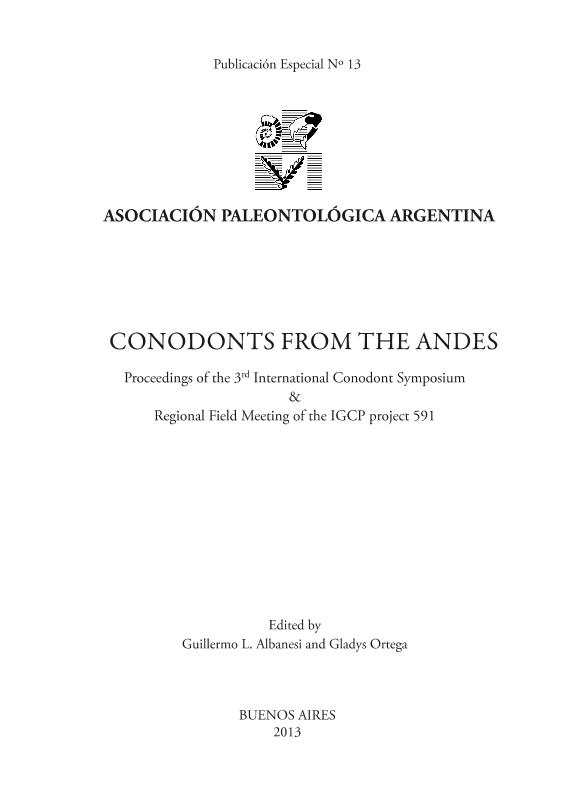Mostrar el registro sencillo del ítem
dc.contributor.author
Voldman, Gustavo Gabriel

dc.contributor.author
Albanesi, Guillermo Luis

dc.contributor.author
Zeballo, Fernando Javier

dc.contributor.author
Monaldi, Cesar Ruben

dc.date.available
2015-12-21T20:17:05Z
dc.date.issued
2013-07
dc.identifier.citation
Voldman, Gustavo Gabriel; Albanesi, Guillermo Luis; Zeballo, Fernando Javier; Monaldi, Cesar Ruben; Early Ordovician (Late Floian) conodonts from the Zenta range, Cordillera Oriental, NW Argentina; Asociación Paleontológica Argentina; Publicación Especial - Asociación Paleontológica Argentina; 13; 1; 7-2013; 123-128
dc.identifier.issn
0328-347X
dc.identifier.uri
http://hdl.handle.net/11336/3129
dc.description.abstract
LOWER Ordovician strata from the Central Andean Basin are superbly exposed in the Zenta Range of the Cordillera Oriental, NW Argentina. At the Laguna Verde section (23°18'S, 65° 1W, 4500 MASL) the sedimentary succession is mostly siliciclastic with subordinate coquinas and calcarenites (Fig. 1). It is unconformably overlain by glacial diamictites and quartzites from the Zapla Formation (Hirnantian). Previous conodont work by Albanesi et al. (2011) recognized the Acodus deltatus – Paroistodus proteus Zone in the nearby Abra de Santa Ana. Aráoz et al. (2008) suggested a Darriwilian to Sandbian age for the strata exposed in the Laguna Verde section, based on the presence of Erismodus and Trapezognathus. In a recent revision of the section, Carlorossi and Heredia (2013) documented from one sample Trapezognathus diprion Lindström(1954) and mentioned the occurrence of Baltoniodus triangularis Lindström (1954) and B. cf. triangularis Lindström (1954) in the same sample (p. 311 and table 2), suggesting a Dapingian age for the upper exposed levels of the Acoite Formation. In order to define the age of aforementioned strata, we took 18 rock samples from the Laguna Verde section plus 2 isolated samples (ZEN17 and ZEN17.2) located 2.5 km to the SW (23°19'S, 65° 0'W), stratigraphically below, which produced a significant conodont fauna, although the diversity is low. The rock samples (24 kg in total), which were digested in 10% acetic acid following the conventional procedures, produced 608 conodont elements. The studied specimens are relatively well preserved (CAI 2, Epstein et al., 1977), with no chemical alteration but abundant fractures that truncate cusps and denticles. The faunal association includes Acodus n. sp. (see Zeballo et al., this volume), Baltoniodus cf. triangularis, Trapezognathus? argentinensis Rao et al.(1994), Trapezognathus diprion, Trapezognathus? primitivus n. sp., Scolopodus houlianzhaiensis An and Xu in An et al. (1983), Drepanodus arcuatus Pander (1856), Drepanoistodus chucaleznensis Albanesi and Aceñolaza (2005), D. costatus (Abaimova, 1971), D. basiovalis (Sergeeva, 1963) and Erraticodon patu Cooper (1981). The record of the taxon Baltoniodus cf. triangularis confirms the presence of the homonymous biozone in the host strata, which indicates the uppermost zone of the Early Ordovician (Floian). According to its age, these strata correlate with the upper part of the Acoite Formation and equivalent units such as the Capillas/Zanjón Formation from the Subandean Ranges. The conodonts are stored in the Museo de Paleontología, Universidad Nacional de Córdoba, with repository code CORD-MP.
dc.format
application/pdf
dc.language.iso
eng
dc.publisher
Asociación Paleontológica Argentina

dc.relation
Proceedings of the 3rd International Conodont Symposium & Regional Field Meeting of the IGCP project 591
dc.rights
info:eu-repo/semantics/openAccess
dc.rights.uri
https://creativecommons.org/licenses/by-nc/2.5/ar/
dc.subject
Conodont
dc.subject
Biostratigraphy
dc.subject
Lower Ordovician
dc.subject
Cordillera Oriental
dc.subject
Argentina
dc.subject.classification
Paleontología

dc.subject.classification
Ciencias de la Tierra y relacionadas con el Medio Ambiente

dc.subject.classification
CIENCIAS NATURALES Y EXACTAS

dc.title
Early Ordovician (Late Floian) conodonts from the Zenta range, Cordillera Oriental, NW Argentina
dc.type
info:eu-repo/semantics/article
dc.type
info:ar-repo/semantics/artículo
dc.type
info:eu-repo/semantics/publishedVersion
dc.date.updated
2016-03-30 10:35:44.97925-03
dc.journal.volume
13
dc.journal.number
1
dc.journal.pagination
123-128
dc.journal.pais
Argentina
dc.journal.ciudad
Buenos Aires
dc.description.fil
Fil: Voldman, Gustavo Gabriel. Universidad Nacional de Córdoba. Facultad de Ciencias Exactas, Físicas y Naturales. Museo de Paleontología; Argentina. Consejo Nacional de Investigaciones Científicas y Técnicas. Centro Científico Tecnológico Córdoba. Centro de Investigaciones en Ciencias de la Tierra; Argentina
dc.description.fil
Fil: Albanesi, Guillermo Luis. Universidad Nacional de Córdoba. Facultad de Ciencias Exactas, Físicas y Naturales. Museo de Paleontología; Argentina. Consejo Nacional de Investigaciones Científicas y Técnicas. Centro Científico Tecnológico Córdoba. Centro de Investigaciones en Ciencias de la Tierra; Argentina
dc.description.fil
Fil: Zeballo, Fernando Javier. Universidad Nacional de Córdoba. Facultad de Ciencias Exactas, Físicas y Naturales. Museo de Paleontología; Argentina
dc.description.fil
Fil: Monaldi, Cesar Ruben. Consejo Nacional de Investigaciones Científicas y Técnicas. Centro Científico Tecnológico Salta; Argentina
dc.journal.title
Publicación Especial - Asociación Paleontológica Argentina

dc.relation.alternativeid
info:eu-repo/semantics/altIdentifier/url/http://www.peapaleontologica.org.ar/index.php/peapa/issue/view/17
Archivos asociados
